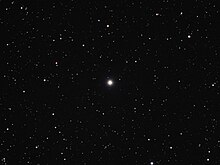
| |
| Observation data Epoch J2000.0 Equinox J2000.0 | |
|---|---|
| Constellation | Andromeda |
| Right ascension | 01 39 20.98857 |
| Declination | +44° 23′ 10.2299″ |
| Apparent magnitude (V) | +5.01 |
| Characteristics | |
| Spectral type | G8 III |
| U−B color index | +0.55 |
| B−V color index | +0.883 |
| Astrometry | |
| Radial velocity (Rv) | +6.54 km/s |
| Proper motion (μ) | RA: −13.395(126) mas/yr Dec.: 8.635(85) mas/yr |
| Parallax (π) | 12.3592 ± 0.1046 mas |
| Distance | 264 ± 2 ly (80.9 ± 0.7 pc) |
| Absolute magnitude (MV) | +0.59 |
| Orbit | |
| Period (P) | 20.8 ± 0.1 yr |
| Eccentricity (e) | 0.368 ± 0.020 |
| Periastron epoch (T) | 43,216 ± 60 MJD |
| Argument of periastron (ω) (secondary) | 144 ± 3° |
| Semi-amplitude (K1) (primary) | 3.01 ± 0.09 km/s |
| Details | |
| Radius | 9 R☉ |
| Luminosity | 47 L☉ |
| Surface gravity (log g) | 2.9 cgs |
| Temperature | 5,070 K |
| Metallicity | –0.21 dex |
| Rotational velocity (v sin i) | 0.0 km/s |
| Other designations | |
| 52 Andromedae, BD+43°343, FK5 2112, HD 10072, HIP 7719, HR 469, SAO 37406, PPM 44275 | |
| Database references | |
| SIMBAD | data |

Chi Andromedae (χ Andromedae, χ And) is the Bayer designation for a star in the northern constellation of Andromeda. It has an apparent visual magnitude of +5.01, which is relatively faint for a naked-eye star. Based upon parallax measurements made during the Gaia mission, Chi Andromedae is located around 264 light-years (81 parsecs) from Earth.
χ Andromedae is a member of 天大將軍 (Tiān Dà Jiāng Jūn), meaning Heaven's Great General, together with γ Andromedae, φ Persei, 51 Andromedae, 49 Andromedae, θ Andromedae, τ Andromedae, 56 Andromedae, β Trianguli, γ Trianguli and δ Trianguli. Consequently, the Chinese name for χ Andromedae itself is 天大將軍五 (Tiān Dà Jiāng Jūn wǔ, English: the Fifth Star of Heaven's Great General.)
This is most likely a spectroscopic binary system with an estimated orbital period of 20.8 years and an eccentricity of 0.37. The primary component has a stellar classification of G8 III, which indicates it is a giant star that has exhausted the supply of hydrogen at its core and evolved away from the main sequence. The outer envelope has expanded to about nine times the radius of the Sun and it is radiating 47 times the luminosity of the Sun at an effective temperature of 5,070 K. This heat gives the star the yellow-hued glow of a G-type star. It appears to be rotating very slowly with no measurable projected rotational velocity. The secondary component seems to be a main-sequence star of the spectral class G or K.
References
- ^ Brown, A. G. A.; et al. (Gaia collaboration) (2021). "Gaia Early Data Release 3: Summary of the contents and survey properties". Astronomy & Astrophysics. 649: A1. arXiv:2012.01533. Bibcode:2021A&A...649A...1G. doi:10.1051/0004-6361/202039657. S2CID 227254300. (Erratum: doi:10.1051/0004-6361/202039657e). Gaia EDR3 record for this source at VizieR.
- ^ Anderson, E.; Francis, Ch. (2012), "XHIP: An extended hipparcos compilation", Astronomy Letters, 38 (5): 331, arXiv:1108.4971, Bibcode:2012AstL...38..331A, doi:10.1134/S1063773712050015, S2CID 119257644.
- Argue, A. N. (1966), "UBV photometry of 550 F, G and K type stars", Monthly Notices of the Royal Astronomical Society, 133 (4): 475–493, Bibcode:1966MNRAS.133..475A, doi:10.1093/mnras/133.4.475.
- van Leeuwen, F. (November 2007), "Validation of the new Hipparcos reduction", Astronomy and Astrophysics, 474 (2): 653–664, arXiv:0708.1752, Bibcode:2007A&A...474..653V, doi:10.1051/0004-6361:20078357, S2CID 18759600.
- ^ Massarotti, Alessandro; et al. (January 2008), "Rotational and Radial Velocities for a Sample of 761 HIPPARCOS Giants and the Role of Binarity", The Astronomical Journal, 135 (1): 209–231, Bibcode:2008AJ....135..209M, doi:10.1088/0004-6256/135/1/209.
- ^ Griffin, R. F. (June 1998), "Spectroscopic binary orbits from photoelectric radial velocities. Paper 140: Chi Andromedae", The Observatory, 118: 158–165, Bibcode:1998Obs...118..158G.
- "* chi And". SIMBAD. Centre de données astronomiques de Strasbourg. Retrieved 2012-06-25.
- (in Chinese) AEEA (Activities of Exhibition and Education in Astronomy) 天文教育資訊網 2006 年 7 月 10 日 Archived 2011-07-16 at the Wayback Machine
- "The Colour of Stars", Australia Telescope, Outreach and Education, Commonwealth Scientific and Industrial Research Organisation, December 21, 2004, archived from the original on 2012-03-18, retrieved 2012-01-16.
External links
| Constellation of Andromeda | |||||||||||||
|---|---|---|---|---|---|---|---|---|---|---|---|---|---|
| Stars |
| ||||||||||||
| |||||||||||||
| Star clusters |
| ||||||||||||
| Nebulae |
| ||||||||||||
| Galaxies |
| ||||||||||||
| |||||||||||||
| |||||||||||||